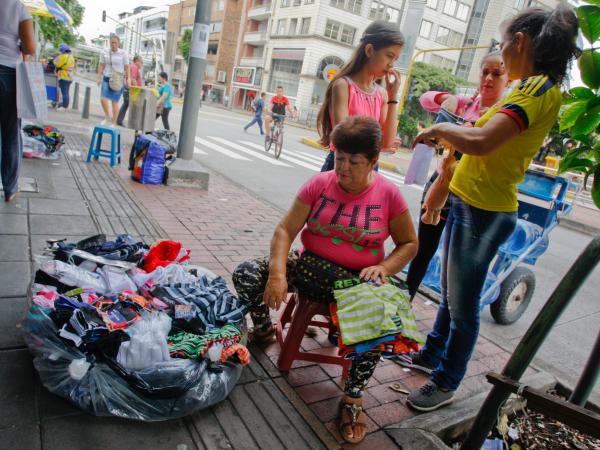With the presentation of the productivity data, next week the minimum wage negotiations in Colombia for 2025 will officially begin, in a scenario that already predicts radical positions among the interested parties, while analysts and universities ask to be consistent with the economic reality of the country.
With the labor unions pointing to a double-digit increase and the businessmen in the field of caution and arguing that they have experienced an unfavorable year due to the slowdown, for now the possibility of an agreement is not seen, although it is still better wait for the sessions of the Labor Concertation Commission to start.
More information: Cementos Argos will sell its stake in Summit Materials, in the United States
In this sense, one of the data that will be important for companies and workers feel their positions is that of productivity, since it is added to that of inflation and with this we have the starting point. Recently the Ministry of Finance indicated that this indicator could remain at 6.2% (5.2% cost of living and 1% productivity).
However, prior to this appointment, the Fiscal Observatory of the Javeriana University published an analysis in which it warns that there are several factors that would work against the large increase requested by the unions, among them productivity, due to the slow pace that has brought the national economy throughout the year.
Minimum wage negotiation – Mintrabajo.
These researchers began by highlighting that, beyond reviewing how much the minimum wage rises, the impact and effect on a large scale must be analyzed, since their accounts show that despite the increases in the legal minimum wage, these have not translated in a significant improvement of workers’ income nor have they positively impacted the salary structure in the country.
“On the contrary, and despite the fact that large increases have been made to the minimum wage, over the last decade, the average wage in the economy has shown a slight but worrying downward trend in its proportion to the minimum wage” , they stated.
Specifically, the three elements that would not favor this time The intentions of a considerable increase in the minimum wage, for the Observatory, are three: informality, inequalities between workers and lack of productivity. Added to this is the lack of access to formal jobs that persists as a structural problem in the labor market.
Also read: Group created to settle lawsuit between EU and Colombia over tariffs on frozen potatoes
“In the informal sector, the situation is more critical. In 2013, the average salary of informal workers represented 93% of the minimum wage, but in 2023 this figure was reduced to 78%. This decrease reflects that increases in the minimum wage are not only insufficient to improve the situation of informal workers, but can accentuate their vulnerability,” the report says.
The report puts on the table that an increase in the minimum wage without structural interventions that encourage formalization and better working conditions could aggravate disparities, while recommending that we take into account that informal workers, which mostly include women and people from rural areas, represent one of the most vulnerable groups in the country.

How much is the monthly salary without transportation assistance?
A general review
Having said all of the above, the analysis suggests paying attention to the way in which the minimum wage increase is currently defined, which for the Fiscal Observatory presents regressive characteristics by imposing the same salary burden on all employers, without considering their payment capabilities. , profits or the size of its operations.
“This uniform measure creates an inherent inequity: employers “With greater financial capacity they do not face an increase proportional to their possibilities, while those with more limited resources are pressured by disproportionate demands that can lead them to informality or even bankruptcy,” they explained.
In this sense and proposing a path that for them is “more equitable” when it comes to improving the salaries and income of workers is the implementation of sectoral negotiation, adapted to the size of the companies; that promotes business growth and thus addresses scourges such as informal employment.
For reading: Sectors and regional opportunities that Corficolombiana is targeting to invest
“This approach would allow unions and employers with greater payment capabilities to agree on fair and sustainable wage conditions, without imposing excessive burdens on micro and small businesses. In this way, an increase in labor income in a more balanced way would be encouraged and the risks of negative impacts on the most vulnerable companies would be reduced. at the same time strengthening the economic and labor stability of the country,” the document says.
On the other hand, they recalled that “economic evidence shows that significant increases in the legal minimum wage can have adverse effects on informal workers, who represent 55.9% of the workforce in the country.”
Although so far there is no official position of any of the parties, the suggested increases range from 6.2% or 6.5% as has been said by the National Government, while the labor confederations say that it should be double digits again, arguing that there is a historical debt with the workers of the country.

Manufacturing production
“We consider that the increase in the minimum wage should be based on the Consumer Price Index (CPI) and the average growth in productivity, as fundamental principles to guarantee that the adjustment preserves the purchasing power of workers and is aligned with the economic capabilities of the country. However, this salary policy must be complemented with a more regionalized approach, which recognizes the economic and social differences between urban and rural areas and specific regions,” they concluded.
Unions and businessmen will have until the end of December to agree on what will happen with the increase in the minimum wage, which in addition to the salary of two million Colombians, is an important indicator to define other elements of the economy and It has a direct impact on the indexation, a life risk factor that they ask to take care of.


















